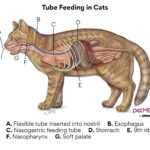What’s in a name? For the fisher cat (Pekania pennanti), the name is certainly misleading. Despite being called a “fisher cat,” this fascinating creature is neither a feline nor does it fish. Often described as “cat-sized,” understanding the true Fisher Cat Size Comparison is key to appreciating this elusive forest dweller of Northern New York and beyond. This article dives into the specifics of fisher cat dimensions, comparing them to animals you might be more familiar with and clarifying common misconceptions about these intriguing members of the weasel family.
Debunking the Name: Fisher Cats Aren’t Cats or Fishers
The fisher cat’s name is a result of mistaken identity and linguistic evolution. Early European settlers are believed to have likened the animal to the European polecat, referred to as a ‘fitche.’ Over time, ‘fitche’ may have morphed into “fisher.” The “cat” part likely arose from their general size and some superficial similarities. While they are about the size of a large domestic cat, the resemblance largely ends there. Fisher cats are mustelids, belonging to the weasel family, a group that also includes otters, badgers, and minks. They are opportunistic omnivores, but their diet primarily consists of meat. While there have been rare instances of them scavenging dead fish, fishing is not part of their typical behavior.
Fisher Cat Size: A Detailed Comparison
When considering fisher cat size comparison, it’s crucial to differentiate between males and females, as they exhibit sexual dimorphism, with males being significantly larger.
Male vs. Female Size Difference
Male fisher cats are considerably larger than their female counterparts. An adult male fisher can range from 35 to 47 inches in total length, including their long, bushy tail, and weigh between 8 and 13 pounds. Females are smaller, typically measuring between 30 to 37 inches in length and weighing only 4 to 6 pounds. This size difference is important to note when trying to identify a fisher cat in the wild or understand descriptions of their size.
Fisher Cat Size Compared to Domestic Cats
The common comparison point for fisher cat size is the domestic cat. While a large male fisher can be comparable in length to a sizeable domestic cat, they are generally more elongated and less compact in build. However, weight provides a better fisher cat size comparison to cats. A large domestic cat might weigh up to 20 pounds or more, potentially outweighing a male fisher. However, the average domestic cat weight is closer to the female fisher’s weight range. Therefore, while in length, a fisher might seem “cat-sized,” their weight distribution and body structure are quite different.
Fisher Cat Size Compared to Other Weasel Family Members
To truly understand fisher cat size comparison, looking at other members of the weasel family is helpful. Fishers are larger than minks and weasels but smaller than otters and badgers. For instance, river otters can weigh anywhere from 12 to 30 pounds and are significantly longer. Badgers are also heavier and bulkier. This places the fisher in a mid-range size category within the mustelid family, being a substantial predator but not the largest of its kin.
Physical Characteristics Beyond Size
Beyond size, other physical traits contribute to the fisher’s appearance. They possess a dense, glossy fur coat that ranges from dark chocolate brown to almost black, providing excellent insulation, especially during winter. This luxurious fur was historically highly sought after, leading to population declines. Their long, bushy tail, often held upright when running, might contribute to the “cat-like” misidentification. Fisher cats also have sharp, retractable claws, similar to cats, which aid in climbing, although they are not primarily arboreal animals.
Habitat, Diet, and Behavior
Fisher cats prefer mature pine forests with dense canopies, providing ample denning sites in hollow logs, stumps, and trees. While omnivorous, their diet leans heavily towards carnivory. They are skilled hunters, preying on rabbits, squirrels, hares, and birds. Notably, they are one of the few predators capable of successfully hunting porcupines, employing a strategy of repeatedly attacking the face to avoid quills. While concerns exist about fisher predation on pets, particularly cats and poultry, such incidents are relatively uncommon but possible, especially for unprotected chickens.
Conservation and Current Status
Due to historical trapping and habitat loss, fisher populations declined significantly. However, thanks to regulated trapping, habitat recovery through forest regrowth, and shifts in human land use, fisher populations have rebounded across their original range. They are currently listed as “Least Concern” by the IUCN, indicating a healthy and stable population. Encounters with fisher cats are becoming more frequent in areas with suitable forest habitats, reminding us of the successful conservation efforts for this remarkable, though misnamed, predator.
Conclusion
In summary, when considering fisher cat size comparison, it’s essential to look beyond the misleading name. They are indeed “cat-sized” in length, particularly males, but are lighter and possess a distinct mustelid body shape. Understanding their size in relation to domestic cats and other weasel family members provides a clearer picture of these fascinating and ecologically important forest inhabitants. They are a testament to the resilience of wildlife and the positive impact of conservation efforts.

